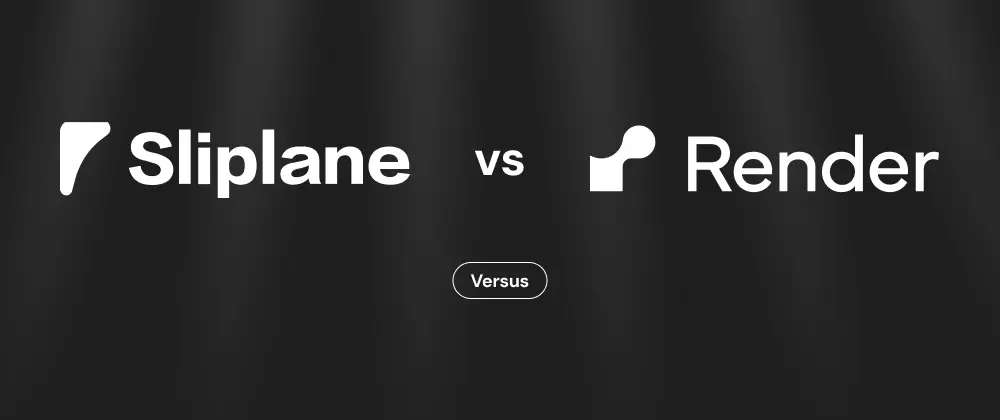
Sliplane vs. Render
 Jonas Scholz
Jonas ScholzSliplane takes the complexity out of container hosting. Instead of paying per service, you get a fully managed platform where you rent a server and run as many containers as it can handle for one fixed monthly price.
How It Works
The concept is simple: You rent a server (starting at 2 vCPUs / 2GB RAM for €9/month), and you can run as many containers as it can handle - all through a web interface with zero server maintenance.
Want to host:
- A Next.js frontend
- A Python API backend
- A PostgreSQL database
- An n8n automation workflow
- A Redis cache
- Monitoring tools
All on one €9/month server? Deploy them all. Your cost stays the same whether you run 1 container or 20.
The Render Approach: Per-Service Simplicity
Render is an excellent platform that makes deployment straightforward with their per-service pricing model. Their philosophy focuses on simplicity and developer experience.
What Render offers:
- Simple git-based deployments
- Automatic SSL and CDN
- Built-in databases and caching
- Easy scaling and environment management
- No infrastructure management required
- Free tier for static sites and web services
The trade-off:
- Costs scale linearly with each service you add
- $7/month for each web service, $7/month for each background worker
- Database plans start at $7/month for PostgreSQL
- Redis plans start at $7/month
- Costs can quickly add up for multi-service applications
Pricing Models: Fixed vs. Per-Service
Both platforms handle deployment complexity, but with fundamentally different pricing approaches:
Render:
- Pay $7/month for each web service
- Pay $7/month for each background worker
- Pay $7/month for each database instance
- Costs grow linearly with your application's complexity
- Predictable pricing per service, but total costs can escalate
Sliplane:
- Pay one fixed price for your entire server (€9-224/month)
- Run unlimited containers within your server's resources
- Includes databases, caches, background workers, frontends - everything
- Perfect for developers who want predictable total costs
Here's how easy deployment is on Sliplane:
When Render Makes Sense
Render is an excellent choice if you:
- Have simple applications with just 1-2 services
- Want the easiest possible deployment with zero configuration
- Need built-in databases without managing them yourself
- Prefer pay-as-you-scale rather than committing to server resources
- Value Render's excellent documentation and developer experience
- Don't mind higher costs for the convenience factor
Render's per-service model works great for simple applications or when you're just getting started.
Real-World Example: Deploying a SaaS MVP
Let's say you're building a SaaS product that needs:
- A React frontend
- A Node.js API backend
- A PostgreSQL database
- A Redis cache
- Background job processing
- Monitoring and analytics
With Render:
- Web service for frontend: $7/month
- Web service for API backend: $7/month
- Background worker for jobs: $7/month
- PostgreSQL database: $7/month
- Redis instance: $7/month
- Total: $35/month (and grows with each additional service)
With Sliplane:
- Choose a €24/month server (3 vCPUs / 4GB RAM)
- Deploy all services as containers
- Automatic SSL, monitoring, and health checks included
- Total: €24/month (no matter how many services you add)
The difference? Render is simpler for single services but costs multiply. Sliplane has fixed costs regardless of complexity.
The Scaling Question
This is where the platforms really differ:
Render scaling:
- Each service scales independently with its own pricing
- Easy horizontal scaling but costs grow proportionally
- Built-in auto-scaling and load balancing
- Clear separation between service types (web/worker/cron)
Sliplane scaling:
- Scale your server size up when you need more resources
- All containers share the same server resources efficiently
- Vertical scaling approach - upgrade the entire server when needed
- No per-service pricing increases
For growing applications, Sliplane's approach often becomes more economical as you add more services.
The Bottom Line
Render is perfect for simple applications where you want the easiest deployment experience. Sliplane is ideal for complex applications where you want predictable costs regardless of service count.
Both platforms eliminate infrastructure management - it's about whether you prefer per-service simplicity or fixed-cost flexibility.
Thinking about switching from per-service to fixed pricing? I'd be happy to help you migrate your applications to Sliplane - just reach out.
Cheers,
Jonas, Co-Founder of sliplane.io